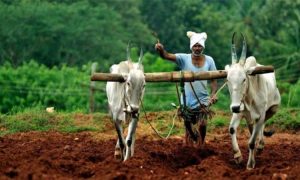On Friday, the Narendra Modi government sought Parliament’s approval for fresh expenditure of Rs 214,580.88 crore towards major subsidies, over and above the Rs 317,865.91 crore budgeted for 2022-23 (April-March).
The extra subsidy outgo, for which the Finance Ministry presented its first tranche of supplementary demand for grants, includes Rs 109,288.95 crore on fertilisers, Rs 80,348.25 crore on food and Rs 24,943.68 crore on petroleum. If passed by both Houses – and assuming no further batches of demands for additional expenditures – it will take the total subsidy bill to Rs 532,446.79 crore: Food (Rs 287,179.34 crore), fertiliser (Rs 214,511.27 crore) and petroleum (Rs 30,756.18 crore).
The Rs 532,446.79 crore spending on subsidy in 2022-23 would be the second highest after the Rs 706,006.53 crore of 2020-21. However, there’s a difference between 2020-21 and 2022-23.
Read More: PAN-Aadhaar Link: Tax Dept Says PAN to Become Inoperative if Not Linked by This Date
In 2020-21, the spike in subsidies (see Table 1) was on account of the Finance Minister Nirmala Sitharaman making a one-time provision to clear all dues to the Food Corporation of India (FCI) and fertiliser companies. The Centre, in previous years, wasn’t providing fully for subsidy, arising from these entities selling grain and fertilisers at below cost to PDS (public distribution system) consumers and farmers respectively. Not wholly funding the difference and on time forced them to borrow, with FCI alone availing loans from the National Small Savings Fund (NSSF) at 7.4-8.8% interest during 2016-17 to 2019-20.
The final subsidy provision of Rs 706,006.53 crore (as against the originally budgeted Rs 227,793.89) helped FCI repay Rs 339,236 crore of outstanding NSSF loans and also clear the fertiliser industry’s subsidy arrears. This exercise of coming clean – the Centre owning up its expenditures, rather than transferring to the balance sheets of FCI and fertiliser firms – led to a spiraling of the subsidy bill. The latter constituted 43.2% of the Centre’s revenue receipts and 20.1% of its total expenditure in 2020-21.
What’s different in 2022-23?
The overshooting of subsidies, both in 2022-23 and 2021-22 (the budget estimate was Rs 336,439.03 crore, against the provisional final of Rs 446,047.72 crore), has been largely courtesy of Covid-19 and the Russia-Ukraine war.
The pandemic resulted in record offtake of rice and wheat through the PDS – 92.88 million tonnes (mt) in 2020-21 and 105.61 mt in 2021-22 – under various welfare schemes, notably the free-grain Pradhan Mantri Garib Kalyan Anna Yojana (PMGKAY). The latter was implemented for eight months (April-November) in 2020-21 and 11 months (May-March) in 2021-22, and extended for another nine months in the current fiscal (April-December). The additional food subsidy spending for which authorisation is now being sought would mainly go to meet the cost of PMGKAY in 2022-23.
Read More: Planning to travel abroad? Here’s how to apply for passport online
In fertiliser and petroleum, the higher subsidy outgo has been due to surge in global prices – from September-October 2021 and, more so, after the Russian invasion of Ukraine – and the Modi government cushioning farmers and consumers from the shock. The maximum retail price of urea hasn’t been raised, while not being allowed to go up much even for di-ammonium phosphate (DAP), India’s second-most consumed fertiliser. Retail prices of petrol and diesel were last revised upwards on April 6 this year – and, in fact, reduced with effect from May 22 following cuts in excise duties.
But insulating the farmer and consumer has also meant compensating fertiliser and oil marketing companies (OMCs) for selling below cost or under-recoveries. That has, of course, added to the government’s subsidy burden.
What are the prospects for the coming year?
Some relief can be expected on all the “3F” subsidies – food, fuel and fertiliser.
In food, the Modi government is unlikely to extend PMGKAY beyond December. State elections in Tripura, Meghalaya and Nagaland in February-March may not be compulsion enough for it. The bigger ones – in Karnataka (May) and Rajasthan, Madhya Pradesh, Chhattisgarh and Telangana (November-December) – are scheduled only later.
Moreover, public rice and wheat stocks, at 55.31 mt on November 1, are the lowest for this date in five years and might not permit further extension of the free-grain scheme. Low stocks will also reduce the FCI’s carrying cost of grain, helping to further prune the Centre’s food subsidy bill.
In fuel, international prices of petrol (Singapore Gasoline) and diesel (Arab Gulf Gasoil) have eased, from their June 2022 average peaks of $148.82 and $170.92 per barrel, to $84.92 and $106.48 respectively now. The latter prices translate into Rs 43.95/litre for petrol and Rs 55.11/litre for diesel. The corresponding base prices (net of freight, taxes and dealer margins) of petrol and diesel in India are at Rs 57.16 and Rs 57.94 per litre respectively.
In other words, the OMCs are making money – and probably being allowed to, in order to recoup past losses. The Rs 24,943.68 crore subsidy authorisation sought under the present supplementary demand for grants is to cover their under-recoveries only in domestic LPG operations, not on petrol and diesel sales.

Coming to fertiliser, Table 2 gives monthly average “pooled” prices of domestic and imported re-gasified liquefied natural gas delivered to urea plants on a gross calorific value (GCV; the total heat released by the combustion of a unit of fuel) basis.
The current price of Rs 1,899.37 per million metric British thermal units (mmBtu) translates into Rs 2,110.41 on a net calorific value (NCV, which excludes the heat in the water vapour produced during combustion and 90% of GCV). Every mmBtu of gas generates 0.25 giga-calories (GCal) of energy, with an average of 5.8 GCal required for producing one tonne of urea.
At existing gas prices, the feedstock cost alone will then come to around Rs 48,961.5 per tonne of urea. One year ago, when the pooled gas price was Rs 1,132.58/mmBtu, the corresponding feedstock cost would have been only Rs 29,195.4 per tonne.
From the table, some softening of gas prices can be seen in recent months. This has been aided by a weakening of global crude prices and the US dollar coming off its September highs. Landed prices of imported fertilisers have also fallen, to $550-600 per tonne (from $900-1,000 in December-January 2021-22) for urea and to $700-720 (from $950-960 in July) for DAP.
What will be the overall subsidy savings?
The food subsidy outgo for the coming fiscal is likely to be contained within Rs 200,000 crore. The same should not exceed Rs 150,000 crore for fertiliser and Rs 25,000 crore for petroleum – assuming no new geopolitical, climate or pandemic shocks. In all, there could be upwards of Rs 150,000 crore in subsidy savings.
What the Modi government does with these savings remains to be seen. Will it redeploy the money in, say, raising annual income support under the PM Kisan Samman Nidhi scheme from Rs 6,000 to Rs 9,000 per farmer? Ultimately, it may boil down to a fine balance between the imperatives of fiscal consolidation and electoral politics.



































